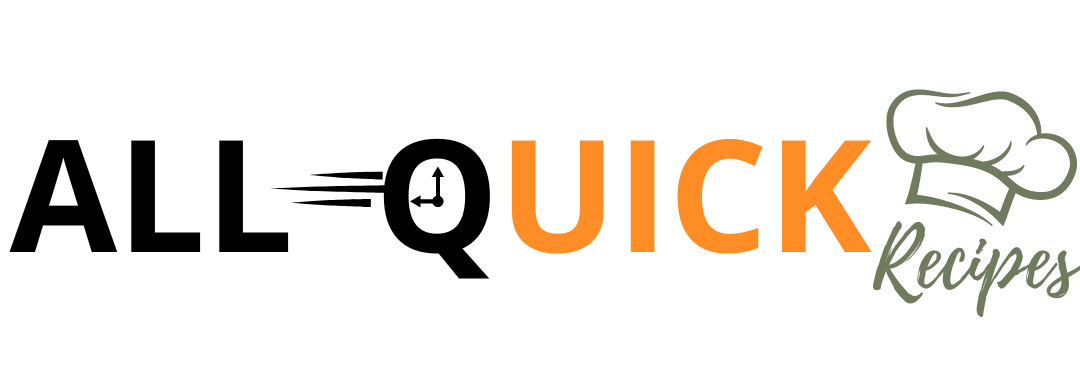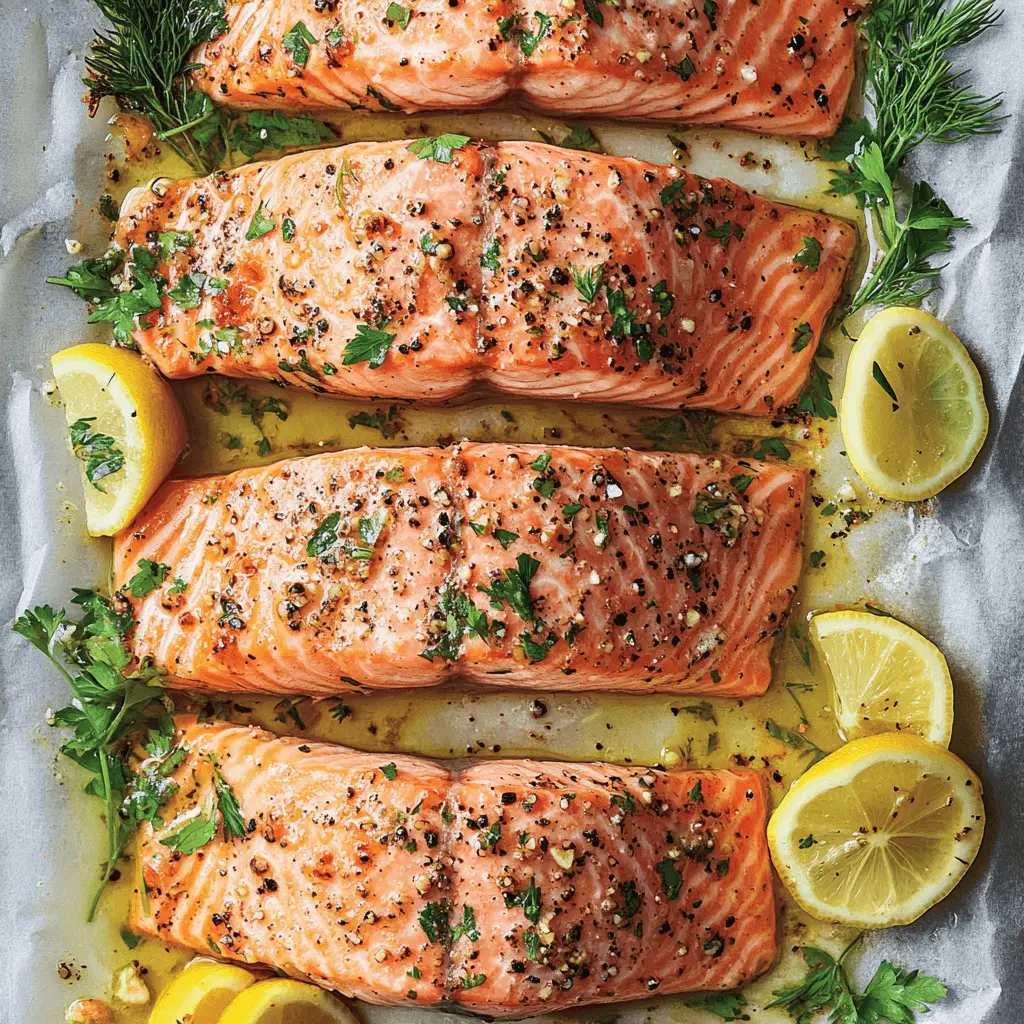Baked Salmon Glow with Astonishing Taste welcomes you into a simple meal that pairs fresh flavors with minimal effort. Many cooks assume fish recipes are tricky, but this one is straightforward. It transforms a busy day into an easy weeknight dinner while satisfying your craving for a flavorful seafood dish.
Salmon is a go-to fish recipe for its mild taste, tender texture, and quick preparation time. It suits family dinners and casual cooking sessions because it delivers a family-friendly seafood option that requires no special skill. Whether you are a cooking enthusiast or just someone seeking a dependable meal, this recipe fits any schedule.
Fresh salmon fillets offer a flaky bite and gentle sweetness that remains moist through baking. That makes it especially appealing for those who want a tasty, wholesome dish without fuss. This introduction sets the stage for a stress-free cooking experience and delivers a nutritious centerpiece for your table. The following sections will guide you through the key benefits, ingredients, and steps you need to make this savory favorite shine every time.
Table of contents
- Key Benefits
- Ingredients
- Instructions
- Pro Tips and Variations
- Conclusion
- FAQs
- Which salmon variety is best for baking?
- How can I tell when my salmon is fully cooked?
- Why is there a white substance on top of my baked salmon?
- How do I keep the salmon from drying out in the oven?
- Is salmon skin edible, and should I keep it on while baking?
- How can I make this recipe gluten-free or dairy-free?
- Can I double or triple this recipe for a large gathering?
- Are there quick side dishes that go well with baked salmon?
- Do I need a special pan or dish to bake salmon?
Key Benefits
Baked salmon stands out for its high nutritional value and easy preparation. This dish offers more than just a tasty main course. It delivers a powerful boost of vital nutrients that help maintain a balanced diet without much effort. Below are a few key benefits that make this recipe worth trying:
- Rich in Omega-3s:
Salmon contains omega-3 fatty acids that support a strong heart and help keep cholesterol in check. Including it in your meal plan can be a simple way to balance your diet.
- Lean Protein Source:
Each bite of salmon delivers quality protein without piling on excess calories. This makes it an appealing choice for those who want to build muscle or stay on track with weight management.
- Packed with Vitamins:
Salmon supplies vitamin D and other essential nutrients. This helps maintain bone health and overall wellness, especially if you do not get enough sun exposure.
- Easy Cleanup:
Baking salmon requires only a single pan or dish, which saves time in the kitchen. Minimal cleanup helps you enjoy dinner without a big mess afterward.
- Supports Various Diets:
Whether you follow a low-carb approach or want a protein-packed meal, salmon fits right in. It is a flexible option that adapts well to different eating plans.
These benefits show why baked salmon is a smart pick for a wholesome, flavor-filled meal.
Ingredients
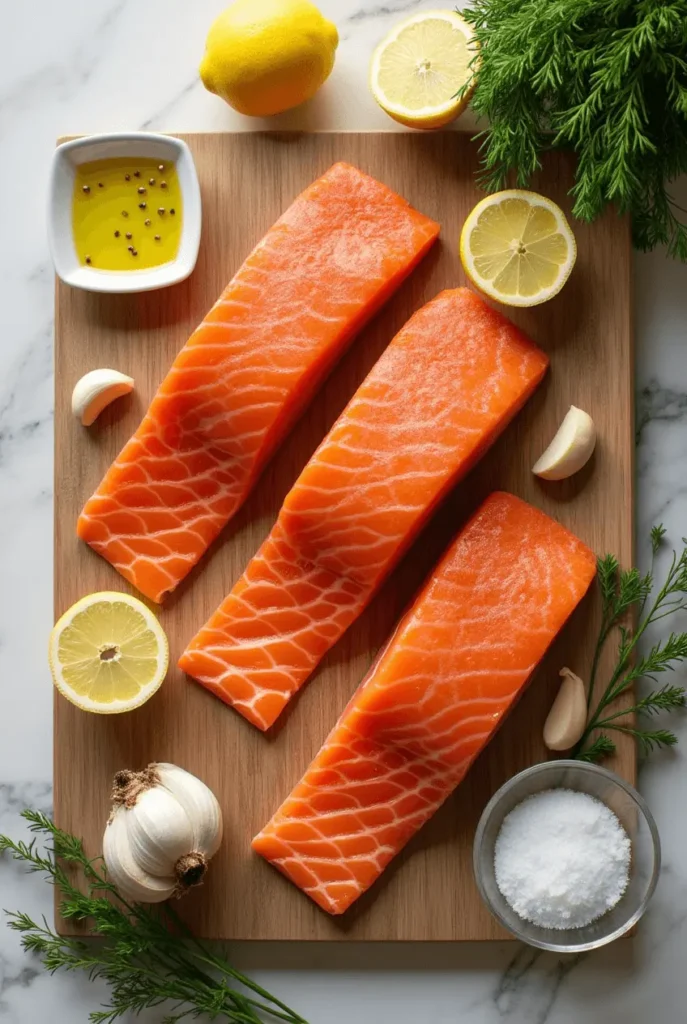
Baked Salmon Glow with Astonishing Taste relies on everyday items that enhance the fish without overpowering its natural sweetness. Below is a list of suggested ingredients. Feel free to adjust quantities based on your serving needs.
-Salmon fillets (6 to 8 ounces each)
– Extra-virgin olive oil or melted butter
– Minced garlic or garlic powder
– Salt and black pepper
– Paprika for gentle heat
– Lemon zest or lemon wedges for brightness
– Herbs such as dill, parsley, or thyme (fresh or dried)
These essentials work together to keep the salmon flaky while boosting flavor. Pick the freshest fillets you can find for the best results. If you prefer something milder, use a light dusting of seasonings. For bolder taste, sprinkle extra paprika or experiment with chili flakes. The next section will show you how to put everything together for a savory and tender bite.
Instructions
Baking salmon is straightforward. With a little care, each fillet emerges moist and flaky. Follow these steps for a reliable outcome every time.
- Preheat the Oven:
Set your oven to 400°F. This temperature helps the salmon cook evenly. Turn on a kitchen timer so you remember when it reaches the right heat level.
- Line the Baking Tray:
Use parchment paper or aluminum foil to cover a baking sheet or dish. This prevents sticking and makes cleanup easier later. A lined tray also keeps moisture close to the salmon fillets as they bake.
- Season the Salmon:
Pat each fillet dry with a paper towel. Arrange them skin-side down on the tray if the skin is still attached. Drizzle olive oil or melted butter on top. Use a marinade brush if you like. Sprinkle salt, black pepper, garlic, and paprika over each piece. Add a bit of lemon zest or place lemon wedges alongside for extra zing.
- Bake the Salmon:
Place the tray in the heated oven. Bake for about 12 to 15 minutes, depending on the thickness of your fillets. A fillet that is around one inch thick often takes closer to 15 minutes. Keep a kitchen timer nearby so you don’t overcook the fish.
- Check for Doneness:
To confirm the salmon is cooked, use a food thermometer. The thickest part of the fillet should reach 145°F (63°C). A fork can help you see if the fish flakes easily. If the texture is firm yet moist, your fillets are ready. If you notice a bit of white protein (albumin) on the surface, that is normal.
- Rest Before Serving:
Remove the tray from the oven. Let the salmon rest for about two minutes. This short break lets the juices redistribute, so every bite remains tender.
By following these simple steps, you can serve a satisfying and evenly cooked seafood meal. This recipe yields juicy, fork-tender fillets without extra fuss.
Pro Tips and Variations
Baking salmon is quick and simple. You can also experiment with a few techniques to boost flavor and suit your preferences. These tips and variations keep the dish fresh and fun:
1. Marinating for Extra Flavor:
A brief marinade can elevate the taste of baked salmon. Combine olive oil, lemon juice, a hint of soy sauce, and your favorite herbs in a shallow dish. Soak the fillets for about 15 minutes. This short step adds subtle tang without overpowering the fish.
2. Adjusting Seasonings:
A dash of chili flakes or cayenne pepper can create a spicy kick. Try a sprinkle of dried oregano or basil for an herby note. If you crave sweetness, brush on honey or maple syrup before baking. These small changes deliver a fresh twist each time you make the recipe.
3. Using the Broiler for Crispness:
For a crisp top layer, switch your oven to the broil setting during the last two minutes. Keep a close watch so the salmon does not burn. This method seals in moisture while adding a golden finish to each fillet.
4. Foil Packet Method:
Wrapping the fish in aluminum foil before baking traps steam and keeps it moist. Include lemon slices and a few herbs inside the packet for extra aroma. This approach also makes cleanup easy because the foil collects any drips.
5. Herb or Nut Crusts:
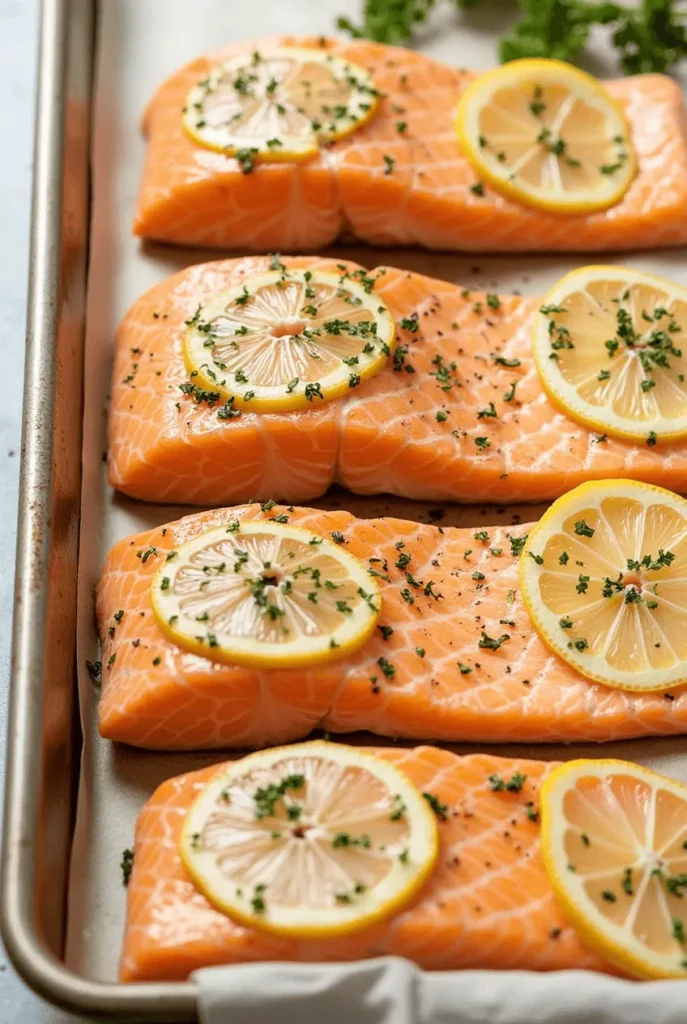
Create a simple herb crust by mixing chopped fresh dill, parsley, or thyme with breadcrumbs and a little melted butter. Spread this blend on top of each fillet before baking. For a nutty variation, use crushed almonds or pistachios to form a delicate crust.
6. Dairy-Free and Gluten-Free Options:
Replace butter with olive oil or a dairy-free spread if you avoid milk products. Switch breadcrumbs for a gluten-free version or use almond flour as a coating. The flavor remains delicious while fitting your dietary needs.
7. Serving Two or a Crowd:
This recipe adapts well to different group sizes. It works for a small household or large gatherings. If you are cooking for more people, arrange extra fillets on a larger baking sheet in a single layer so each piece cooks evenly.
Feel free to explore these ideas to make your baked salmon unique and satisfying. A few small tweaks or simple touches can broaden your menu and help you discover fresh ways to present a familiar dish.
Conclusion
Baked Salmon Glow with Astonishing Taste offers a simple way to enjoy tender seafood at home. It highlights the salmon’s natural flavors while adding just the right seasonings for a balanced, mouthwatering meal. From the quick prep to the gentle baking process, each step is designed to preserve moisture and produce a flaky texture that pairs well with many sides.
Salmon is not only a lean protein choice; it also contains nutrients like omega-3 fatty acids and vitamin D. These factors make it a practical option for healthy eating plans. A single dish can serve a small family or an entire gathering, relying on everyday ingredients that you likely have in your kitchen. If you choose to modify the recipe, there are numerous ways to jazz up the flavor—spicy rubs, creamy sauces, or tangy marinades.
Many people think fish meals are difficult. In reality, this approach keeps things straightforward. A hot oven, basic seasonings, and a short cooking time are all you need for a satisfying result. As you experiment with the variations and garnishes shared here, you will discover new ways to prepare and present this easy favorite.
Whether you want an elegant dinner or a quick midweek bite, this recipe steps up to the task. Enjoy the wholesome taste and inviting aroma that come from a balanced blend of flavors and a simple method. With all the tips provided, you can feel confident that your baked salmon will not only taste good but also serve as a smart option for overall well-being.
___________________________________________
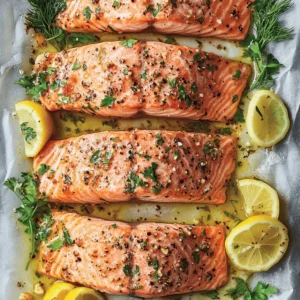
Baked Salmon
Ingredients
Salmon fillets (6 to 8 ounces each)
Extra-virgin olive oil or melted butter
Minced garlic or garlic powder
Salt and black pepper
Paprika for gentle heat
Lemon zest or lemon wedges for brightness
Herbs such as dill, parsley, or thyme (fresh or dried)
Instructions
Preheat the Oven:
- Set your oven to 400°F. This temperature helps the salmon cook evenly. Turn on a kitchen timer so you remember when it reaches the right heat level.
Line the Baking Tray:
- Use parchment paper or aluminum foil to cover a baking sheet or dish. This prevents sticking and makes cleanup easier later. A lined tray also keeps moisture close to the salmon fillets as they bake.
Season the Salmon:
- Pat each fillet dry with a paper towel. Arrange them skin-side down on the tray if the skin is still attached. Drizzle olive oil or melted butter on top. Use a marinade brush if you like. Sprinkle salt, black pepper, garlic, and paprika over each piece. Add a bit of lemon zest or place lemon wedges alongside for extra zing.
Bake the Salmon:
- Place the tray in the heated oven. Bake for about 12 to 15 minutes, depending on the thickness of your fillets. A fillet that is around one inch thick often takes closer to 15 minutes. Keep a kitchen timer nearby so you don’t overcook the fish.
Check for Doneness:
- To confirm the salmon is cooked, use a food thermometer. The thickest part of the fillet should reach 145°F (63°C). A fork can help you see if the fish flakes easily. If the texture is firm yet moist, your fillets are ready. If you notice a bit of white protein (albumin) on the surface, that is normal.
Rest Before Serving:
- Remove the tray from the oven. Let the salmon rest for about two minutes. This short break lets the juices redistribute, so every bite remains tender.
Notes
- Calories: 350
- Fat: 20g
- Protein: 35g
- Carbohydrates: 5g
- Fiber: 1g
- Sugar: 2g
- Sodium: 600mg
FAQs
Below are frequently asked questions that help you refine your approach to baked salmon. These cover cooking methods, storage tips, substitutions, and more. Feel free to adapt them based on your specific needs.
Many cooks prefer wild-caught salmon for its rich color and firm texture. Examples include sockeye, coho, or king salmon. That said, Atlantic salmon (often farm-raised) can also work well. The key is to pick fresh, high-quality fillets that feel firm and have a mild ocean scent.
A reliable way is to use a food thermometer. The thickest part of the salmon should reach 145°F (63°C). If you do not have a thermometer, gently press the fillet with a fork. It should flake easily and show a slightly opaque center. Overcooking can lead to dryness, so keep a close eye on the baking time.
That white substance is albumin, a naturally occurring protein that emerges as salmon cooks. It might look unappealing, but it is harmless. A brief brine or marinade before baking can lower the amount of albumin. Cooking at a moderate temperature also helps reduce it, but seeing some on the surface is perfectly normal.
Lower temperatures and shorter cooking times help maintain moisture. Drizzling the fish with olive oil or melted butter adds a layer of fat that seals in natural juices. You can also bake the fillets in foil packets. This method traps steam and prevents the salmon from drying out.
Salmon skin is edible and can turn crispy if baked or broiled at the end. Some people enjoy the texture, while others prefer removing it after cooking. Leaving the skin on protects the fillet from direct heat and makes it easier to slide a spatula underneath when serving.
For a gluten-free meal, skip regular breadcrumbs if you choose a crust topping and use a gluten-free version. Almond flour or crushed gluten-free crackers can work too. For dairy-free, replace butter with extra-virgin olive oil or a plant-based substitute. The result still tastes delicious.
Absolutely. Arrange extra fillets on a larger baking sheet in a single layer. Ensure each fillet has space around it, so the heat circulates evenly. You may need to adjust baking times if your oven is packed, but the basic process remains the same.
Simple steamed vegetables, mixed greens, or a quick pasta toss all pair nicely. For faster prep, roast chopped veggies—like zucchini or bell peppers—on a second tray. If you prefer grains, try cooking rice or couscous while the salmon bakes. The fish’s mild taste blends well with many side options.
You can use any sturdy baking sheet or oven-safe dish. Line it with parchment paper or foil to prevent sticking. If you plan to broil the fish at the end for crispness, check that your tray can handle higher broiler temperatures safely.
Which salmon variety is best for baking?
Many cooks prefer wild-caught salmon for its rich color and firm texture. Examples include sockeye, coho, or king salmon. That said, Atlantic salmon (often farm-raised) can also work well. The key is to pick fresh, high-quality fillets that feel firm and have a mild ocean scent.
How can I tell when my salmon is fully cooked?
A reliable way is to use a food thermometer. The thickest part of the salmon should reach 145°F (63°C). If you do not have a thermometer, gently press the fillet with a fork. It should flake easily and show a slightly opaque center. Overcooking can lead to dryness, so keep a close eye on the baking time.
Why is there a white substance on top of my baked salmon?
That white substance is albumin, a naturally occurring protein that emerges as salmon cooks. It might look unappealing, but it is harmless. A brief brine or marinade before baking can lower the amount of albumin. Cooking at a moderate temperature also helps reduce it, but seeing some on the surface is perfectly normal.
How do I keep the salmon from drying out in the oven?
Lower temperatures and shorter cooking times help maintain moisture. Drizzling the fish with olive oil or melted butter adds a layer of fat that seals in natural juices. You can also bake the fillets in foil packets. This method traps steam and prevents the salmon from drying out.
Is salmon skin edible, and should I keep it on while baking?
Salmon skin is edible and can turn crispy if baked or broiled at the end. Some people enjoy the texture, while others prefer removing it after cooking. Leaving the skin on protects the fillet from direct heat and makes it easier to slide a spatula underneath when serving.
How can I make this recipe gluten-free or dairy-free?
For a gluten-free meal, skip regular breadcrumbs if you choose a crust topping and use a gluten-free version. Almond flour or crushed gluten-free crackers can work too. For dairy-free, replace butter with extra-virgin olive oil or a plant-based substitute. The result still tastes delicious.
Can I double or triple this recipe for a large gathering?
Absolutely. Arrange extra fillets on a larger baking sheet in a single layer. Ensure each fillet has space around it, so the heat circulates evenly. You may need to adjust baking times if your oven is packed, but the basic process remains the same.
Are there quick side dishes that go well with baked salmon?
Simple steamed vegetables, mixed greens, or a quick pasta toss all pair nicely. For faster prep, roast chopped veggies—like zucchini or bell peppers—on a second tray. If you prefer grains, try cooking rice or couscous while the salmon bakes. The fish’s mild taste blends well with many side options.
Do I need a special pan or dish to bake salmon?
You can use any sturdy baking sheet or oven-safe dish. Line it with parchment paper or foil to prevent sticking. If you plan to broil the fish at the end for crispness, check that your tray can handle higher broiler temperatures safely.
